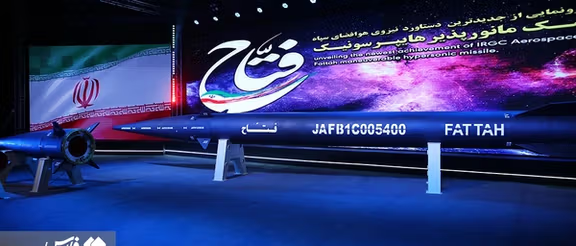Iran's Claim Of Making Hypersonic Missile, Myth Or Reality?

Iran has unveiled what it describes as its first domestically made hypersonic ballistic missile, while available facts about the weapon cast doubt on the claim.

Iran has unveiled what it describes as its first domestically made hypersonic ballistic missile, while available facts about the weapon cast doubt on the claim.
A ceremony to present Fattah missile on Tuesday was attended by President Ebrahim Raisi, Revolutionary Guards Chief Commander Major General Hossein Salami, and IRGC Aerospace Force Commander Brigadier General Amir Ali Hajizadeh as well as a dozen other senior officials.
Boastful statements by IRGC commanders about the unprecedented level of cooperation between the Raisi administration and the IRGC, which – given the occasion it was announced – will work as a prod to heighten Western concerns about Iran's missile capabilities.
Iran claims its hypersonic missile has a range of 1,400 kilometers, can breach and overcome all anti-missile shields, and hits speeds of Mach 13-15, which means about 13 to 15 times faster than the speed of sound -- known as Mach 1.
Currently available technology perhaps support hypersonic missiles flying at 5-8 Machs, so Iran's claim of 15 mach speed seems an exaggeration.

For a missile to be called hypersonic, it should fly at least five times faster than the speed of sound. The threshold of Mach 5 is used because a range of physical effects start becoming a significant engineering challenge at that speed.
In addition, a true hypersonic missile should also be maneuverable to be useful, which poses a significant challenge not only to Iran but even for great military powers, such as the United States, which still has not fielded such a weapon.
The term is also used generally to refer to two types of weapons that are being developed through contemporary defense programs: Hypersonic glide vehicles (HGVs) and hypersonic cruise missiles (HCMs). It is not clear which type Fattah is. However, since Iran described it as ballistic, it is most probably an HGV.
But even that description is misleading. An HGV is a relatively large projectile lifted by a ballistic missile into the atmosphere, which at a certain point begins gliding toward its target.
An HCM is a cruise missile, which means it does not glide but is self-propelled at a hypersonic speed.

No Iranian official has elaborated on when Fattah would hit hypersonic speed: during its first phase of flight powered by a ballistic missile, or when it is gliding toward the target.
Unless Iranian authorities say at what altitude the missile will hit Mach 15, the claim is not even verifiable.
The IRGC claims that with a solid fuel propulsion system and a second-stage mobile nozzle, the missile has the ability to reach very high speeds and perform various maneuvers in and out of the Earth’s atmosphere in order to overcome all types of air defense systems. Hajizadeh saying Iran is now among only four countries that have the technology to manufacture hypersonic missiles. He did not name the countries he had in mind.
According to Stockholm International Peace Research Institute (SIPRI), the reports about such missiles demonstrate how confusing -- and potentially distorting -- the term ‘hypersonic’ is, noting that some of the news coverage of similar events have indicated “a lack of understanding of the different types of ‘hypersonic missiles’, the role of their speed and maneuvering capabilities, the physics behind them, and their military capabilities and missions.”
Hajizadeh added that unlike other types of missiles, Fattah cannot be countered by any defense system, noting that the hypersonic missile cannot be destroyed by any missile due to its cross-range maneuvers, meaning movement in various directions and heights.
However, a Brookings Institution report in May– titled ‘Don’t believe the hypersonic hype’ -- , debunked several such claims, and mentioned the case of the Russian Kinzhal missile, which President Vladimir Putin had announced in 2018 as a “hypersonic” weapon that could overcome all existing air defense systems. However, in May, Ukraine used US-supplied Patriot batteries to down several Kinzhals, shattering the myth of a Russian hypersonic weapon.
SIPRI says that the questioning why certain actors adopt this terminology – given a lack of understanding of the limitations of this descriptor -- can “help reveal motivations and vested interests in the hype around hypersonic missiles, i.e. to appear threatening.”
Highlighting that Supreme Leader Ali Khamenei has supported and approved the missile activities and even has chosen the name 'Fattah’ -- which means ‘the opener,’ Hajizadeh said “Our activities in this field do not end with the manufacturing of this missile. We will continue this path so that no enemy even imagines attacking Iran.”